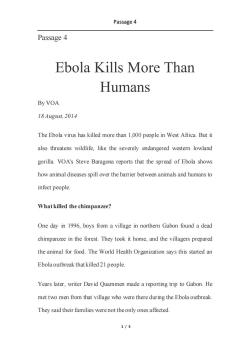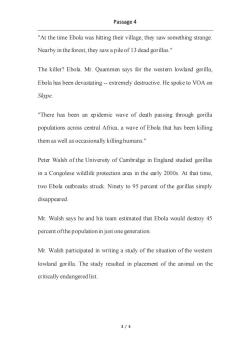私立华联学院:《英文报刊阅读》课程教学资源(电子教案)Passage 4 Ebola kills more than humans(致命病毒埃博拉)

Passage4 Passage 4 Ebola Kills More Than Humans By VOA 18 August,2014 The Ebola virus has killed more than 1,000 people in West Africa.But it also threatens wildlife,like the severely endangered western lowland gorilla.VOA's Steve Baragona reports that the spread of Ebola shows how animal diseases spill over the barrier between animals and humans to infect people What killed the chimpanzee? One day in 1996,boys from a village in northern Gabon found a dead chimpanzee in the forest.They took it home,and the villagers prepared the animal for food.The World Health Organization says this started an Ebola outbreak that killed 21 people. Years later,writer David Quammen made a reporting trip to Gabon.He met two men from that village who were there during the Ebola outbreak. They said their families were not the only ones affected 1/5
Passage 4 1 / 5 Passage 4 Ebola Kills More Than Humans By VOA 18 August, 2014 The Ebola virus has killed more than 1,000 people in West Africa. But it also threatens wildlife, like the severely endangered western lowland gorilla. VOA's Steve Baragona reports that the spread of Ebola shows how animal diseases spill over the barrier between animals and humans to infect people. What killed the chimpanzee? One day in 1996, boys from a village in northern Gabon found a dead chimpanzee in the forest. They took it home, and the villagers prepared the animal for food. The World Health Organization says this started an Ebola outbreak that killed 21 people. Years later, writer David Quammen made a reporting trip to Gabon. He met two men from that village who were there during the Ebola outbreak. They said their families were not the only ones affected

Passage4 "At the time Ebola was hitting their village,they saw something strange Nearby in the forest,they saw a pile of 13 dead gorillas." The killer?Ebola.Mr.Quammen says for the western lowland gorilla. Ebola has been devastating--extremely destructive.He spoke to VOA on Skype. "There has been an epidemic wave of death passing through gorilla populations across central Africa,a wave of Ebola that has been killing them as well as occasionally killing humans." Peter Walsh of the University of Cambridge in England studied gorillas in a Congolese wildlife protection area in the early 2000s.At that time, two Ebola outbreaks struck.Ninety to 95 percent of the gorillas simply disappeared. Mr.Walsh says he and his team estimated that Ebola would destroy 45 percent ofthe population in just one generation. Mr.Walsh participated in writing a study of the situation of the western lowland gorilla.The study resulted in placement of the animal on the critically endangered list. 215
Passage 4 2 / 5 "At the time Ebola was hitting their village, they saw something strange. Nearby in the forest, they saw a pile of 13 dead gorillas." The killer? Ebola. Mr. Quammen says for the western lowland gorilla, Ebola has been devastating -- extremely destructive. He spoke to VOA on Skype. "There has been an epidemic wave of death passing through gorilla populations across central Africa, a wave of Ebola that has been killing them as well as occasionally killing humans." Peter Walsh of the University of Cambridge in England studied gorillas in a Congolese wildlife protection area in the early 2000s. At that time, two Ebola outbreaks struck. Ninety to 95 percent of the gorillas simply disappeared. Mr. Walsh says he and his team estimated that Ebola would destroy 45 percent of the population in just one generation. Mr. Walsh participated in writing a study of the situation of the western lowland gorilla. The study resulted in placement of the animal on the critically endangered list

Passage4 In this file photo,a Lowland Gorilla is seen in the Kahuzi-Biega National Park in South Kivu,eastern Democrati Republic of Congo on Nov.5,2012. Disease and the Spillover Effect For David Quammen,the story ofthe 13 dead gorillas outside the Gabon village shows how new infectious diseases are connecting humans and animals. Mr.Quammen wrote a book called Spillover:Animal Infections and the Next Human Pandemic.This book describes how these diseases jump,or move,from animals to people at an increasingrate. Rats carry many different diseases The fleas on rats then transmit disease to humans. This is not new. Bubonic plague,for example,jumped from rodents like rats to humans through infected fleas,a tiny biting insect.That plague killed as many as 60 percent of Europeans in the 14th century
Passage 4 3 / 5 Disease and the Spillover Effect For David Quammen, the story of the 13 dead gorillas outside the Gabon village shows how new infectious diseases are connecting humans and animals. Mr. Quammen wrote a book called Spillover: Animal Infections and the Next Human Pandemic. This book describes how these diseases jump, or move, from animals to people at an increasing rate. This is not new. Bubonic plague, for example, jumped from rodents like rats to humans through infected fleas, a tiny biting insect. That plague killed as many as 60 percent of Europeans in the 14th century. In this file photo, a Lowland Gorilla is seen in the Kahuzi-Biega National Park in South Kivu, eastern Democratic Republic of Congo on Nov. 5, 2012. Rats carry many different diseases. The fleas on rats then transmit disease to humans

Passage 4 But David Quammen says many new diseases,especially viruses,seem to be developing. "Something seems to be different because we've seen a lot of these new diseases,especially viral diseases,emerging over the last five or six decades.And that,of course,raises the question of,why?What's different now?m Mr.Quammen says one reason is that the human population is going deeper and deeper into habitats-or living areas--where humans are finding new creatures. "There are now seven billion of us on the planet.Were going into these diverse ecosystems.Were cutting down trees,were building mines,we're building villages and roads.And we're coming in contact with these animals.And we're giving the viruses those animals carry the opportunity to jump to a new host,to spill over into human populations." Contamination Is A Two-Way Street In the world of diseases,contamination--spreading germs--goes two ways. Peter Walsh says ecotourism has helped protect the living areas of apes But he says people taking those environmental trips are killing the apes 415
Passage 4 4 / 5 But David Quammen says many new diseases, especially viruses, seem to be developing. "Something seems to be different because we've seen a lot of these new diseases, especially viral diseases, emerging over the last five or six decades. And that, of course, raises the question of, why? What's different now?" Mr. Quammen says one reason is that the human population is going deeper and deeper into habitats – or living areas -- where humans are finding new creatures. "There are now seven billion of us on the planet. We're going into these diverse ecosystems. We're cutting down trees, we're building mines, we're building villages and roads. And we're coming in contact with these animals. And we're giving the viruses those animals carry the opportunity to jump to a new host, to spill over into human populations." Contamination Is A Two-Way Street In the world of diseases, contamination -- spreading germs -- goes two ways. Peter Walsh says ecotourism has helped protect the living areas of apes. But he says people taking those environmental trips are killing the apes

Passage 4 they come to see.He says this happens because people bring their viruses with them. "Human respiratory viruses are the number one source of death in habituated chimpanzees and gorillas.In chimpanzees,half of the deaths are caused by human respiratory viruses. Mrithi,a 20-year-old male western lowland gorilla. Mr.Walsh wants apes that come near tourists to receive vaccine against human diseases such as measles. He and his scientific team also call for better enforcement of laws against harming the severely endangered western lowland gorilla.In addition, they are asking for better protection oftheir decreasing habitat. But the gorillas are still defenseless to a disease like Ebola that kills both humans and our wild relatives. I'm Anna Matteo. This story is based on a report by VOA reporter Steve Baragona.It was adapted by Anna Matteo for Learning English. 515
Passage 4 5 / 5 they come to see. He says this happens because people bring their viruses with them. "Human respiratory viruses are the number one source of death in habituated chimpanzees and gorillas. In chimpanzees, half of the deaths are caused by human respiratory viruses." Mr. Walsh wants apes that come near tourists to receive vaccine against human diseases such as measles. He and his scientific team also call for better enforcement of laws against harming the severely endangered western lowland gorilla. In addition, they are asking for better protection of their decreasing habitat. But the gorillas are still defenseless to a disease like Ebola that kills both humans and our wild relatives. I'm Anna Matteo. This story is based on a report by VOA reporter Steve Baragona. It was adapted by Anna Matteo for Learning English. Mrithi, a 20-year-old male western lowland gorilla
按次数下载不扣除下载券;
注册用户24小时内重复下载只扣除一次;
顺序:VIP每日次数-->可用次数-->下载券;
- 私立华联学院:《英文报刊阅读》课程教学资源(电子教案)Passage 3 Klose calls it a day for Germany(德国国足克洛泽退役).doc
- 私立华联学院:《英文报刊阅读》课程教学资源(电子教案)Passage 2 Jackie Chan's son Jaycee faces being 'detained for six months'(名人吸毒).doc
- 私立华联学院:《英文报刊阅读》课程教学资源(电子教案)Passage 17 Travel agencies told to regulate tourist(中国将不文明旅客列入黑名单).doc
- 私立华联学院:《英文报刊阅读》课程教学资源(电子教案)Passage 16 China Russia pledge to strengthen cooperation(中俄承诺加强合作).doc
- 私立华联学院:《英文报刊阅读》课程教学资源(电子教案)Passage 15 APEC promises to bring new prosperity(中国通过亚太经合组织会议承诺中国将带领各成员国共同发展繁荣).doc
- 私立华联学院:《英文报刊阅读》课程教学资源(电子教案)Passage 14 Sitcoms mine the hardships of young adults worldwide(美剧《老友记》经典二十年).doc
- 私立华联学院:《英文报刊阅读》课程教学资源(电子教案)Passage 13 Police seek motive in fatal Washington state school shooting(美国校园枪击案).doc
- 私立华联学院:《英文报刊阅读》课程教学资源(电子教案)Passage 12 Death incites unrest(美国种族主义).doc
- 私立华联学院:《英文报刊阅读》课程教学资源(电子教案)Passage 11 Student calls for samesex marriage(中国大学生呼吁同性恋婚姻合法化).doc
- 私立华联学院:《英文报刊阅读》课程教学资源(电子教案)Passage 10 Hong Kong's Occupy Central participants urged to reflect(香港‘占中’事件).doc
- 私立华联学院:《英文报刊阅读》课程教学资源(电子教案)Passage 1 Stay away from these(远离致命动物).doc
- 私立华联学院:《英文报刊阅读》课程教学资源(练习题,十套)Voice of Courage政治人物_Voice of Courage.docx
- 私立华联学院:《英文报刊阅读》课程教学资源(练习题,十套)Tragic End to Beslan Hostage Crisis恐怖主义_Tragic End to Beslan Hostage Crisis.docx
- 私立华联学院:《英文报刊阅读》课程教学资源(练习题,十套)The Gay-Marriage Flap; The Government Is out of Step with Public Opinion同性恋婚姻_The Gay-Marriage Flap; The Government Is out of Step with Public Opinion.docx
- 私立华联学院:《英文报刊阅读》课程教学资源(练习题,十套)Out of the Comfort Zone欧洲妇女面面观_Out of the Comfort Zone.docx
- 私立华联学院:《英文报刊阅读》课程教学资源(练习题,十套)Methane in Martian Air Suggests Life Beneath the Surface科技报道_Methane in Martian Air Suggests Life Beneath the Surface.docx
- 私立华联学院:《英文报刊阅读》课程教学资源(练习题,十套)Is Heart Surgery Worth It医学报道_Is Heart Surgery Worth It.docx
- 私立华联学院:《英文报刊阅读》课程教学资源(练习题,十套)Investment Fever in Clean-Energy经济投资_Investment Fever in Clean.docx
- 私立华联学院:《英文报刊阅读》课程教学资源(练习题,十套)Environmental Protection 环境保护全球变暖_Global Warming Threatens Deserts.docx
- 私立华联学院:《英文报刊阅读》课程教学资源(练习题,十套)A World View Must Be Part of School Culture教育报道_A World View Must Be Part of School Culture.docx
- 私立华联学院:《英文报刊阅读》课程教学资源(电子教案)Passage 5 Outbreak of fear(埃博拉引发恐慌).doc
- 私立华联学院:《英文报刊阅读》课程教学资源(电子教案)Passage 6 Obama leads US in remembrance of Sept 11 victims(美国911反恐纪念13周年).doc
- 私立华联学院:《英文报刊阅读》课程教学资源(电子教案)Passage 7 The big freeze(冰桶挑战).doc
- 私立华联学院:《英文报刊阅读》课程教学资源(电子教案)Passage 8 Alibaba jumps more than 40 percent in trading debut(阿里巴巴首次公开上市).doc
- 私立华联学院:《英文报刊阅读》课程教学资源(电子教案)Passage 9 'Gutter oil' scandal tarnishing Hong Kong’s reputation, says health secretary(食品安全:地沟油).doc
- 私立华联学院:《日语能力拓展》课程教学资源(参考资料)日本文化室资料_京都.ppt
- 私立华联学院:《日语能力拓展》课程教学资源(参考资料)日本文化室资料_广东料理(広東料理).pptx
- 私立华联学院:《日语能力拓展》课程教学资源(参考资料)日本文化室资料_日本历代天皇、将军、首相及其他_历代将军_历代征夷大将军(歴代の征夷大将軍).doc
- 私立华联学院:《日语能力拓展》课程教学资源(参考资料)日本文化室资料_日本历代天皇、将军、首相及其他_历代日本天皇_歴代の日本天皇.doc
- 私立华联学院:《日语能力拓展》课程教学资源(参考资料)日本文化室资料_日本历代天皇、将军、首相及其他_历代日本首相_歴代の内閣総理大臣.doc
- 私立华联学院:《日语能力拓展》课程教学资源(参考资料)日本文化室资料_日本历代天皇、将军、首相及其他_日本网站一览_日本网络资源一览表.doc
- 私立华联学院:《日语能力拓展》课程教学资源(参考资料)日本文化室资料_日本历代天皇、将军、首相及其他_日本诺贝尔奖获得者(日本人のノーベル賞受賞者).doc
- 私立华联学院:《日语能力拓展》课程教学资源(参考资料)日本文化室资料_日本历代天皇、将军、首相及其他_都道府县人口(都道府県の人口).doc
- 私立华联学院:《日语能力拓展》课程教学资源(参考资料)日本文化室资料_日本料理简介(日本料理りょうり).ppt
- 私立华联学院:《日语能力拓展》课程教学资源(参考资料)日本文化室资料_東京.pptx
- 《日语能力拓展》课程教学资源(PPT课件讲稿)第一部 日本の国土と自然.ppt
- 《日语能力拓展》课程教学资源(PPT课件讲稿)第三部 现代日本人の生活.ppt
- 私立华联学院:《日语能力拓展》课程教学资源(教案讲义)使い分け(一).pdf
- 私立华联学院:《日语能力拓展》课程教学资源(教案讲义)使い分け(三).pdf
- 私立华联学院:《日语能力拓展》课程教学资源(教案讲义)使い分け(二).pdf
